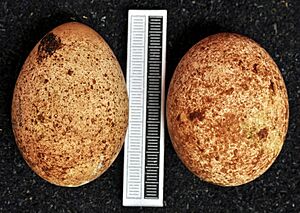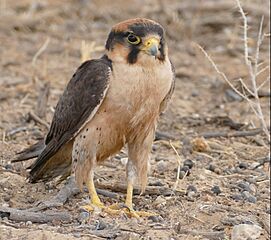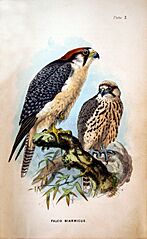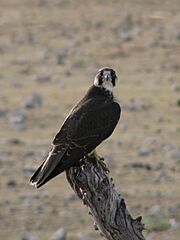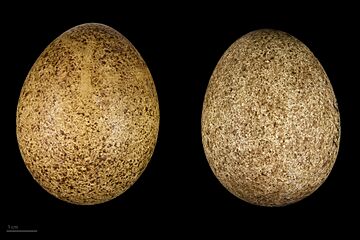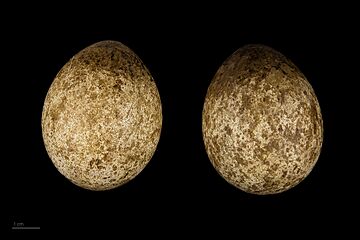Lanner falcon facts for kids
Quick facts for kids Lanner falcon |
|
|---|---|
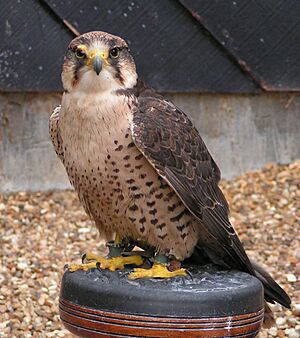 |
|
| Adult Falco biarmicus feldeggi | |
| Conservation status | |
| Scientific classification | |
| Genus: |
Falco
|
| Species: |
biarmicus
|
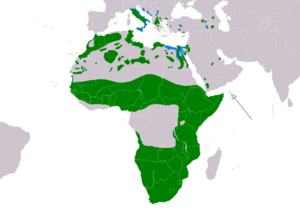 |
|
| Range of Falco biarmicus Resident Non-breeding Possibly Extant (resident) | |
| Synonyms | |
|
Falco feldeggii Schlegel, 1841 |
|
The lanner falcon (Falco biarmicus) is a medium-sized bird of prey. These amazing birds live and breed in Africa, parts of southeast Europe, and a small area of Asia. They like open spaces and usually stay in one area. However, some lanner falcons travel further after their breeding season.
Lanner falcons are quite large. They hunt and eat other birds and even bats. In Ancient Egypt, people thought falcons were sacred. It's believed that either the lanner or peregrine falcon was the special bird. Important Egyptian gods, like Ra and Horus, were often shown as a man with the head of a lanner falcon.
Contents
About the Lanner Falcon's Name
The lanner falcon was first officially described by a Dutch scientist named Coenraad Jacob Temminck in 1825. He gave it the scientific name Falco biarmicus.
The word Falco comes from a Latin word meaning "sickle." This might be because of the falcon's curved talons or its hooked beak. The English word "lanner" probably comes from an old French word, lanier. The name "lanner" has been used in English since about the year 1400.
Scientists believe the lanner falcon is one of the oldest types of falcons in its group, called "hierofalcons." This idea is supported by where these birds live around the world.
There are five different types, or subspecies, of lanner falcons:
- F. b. biarmicus: This type lives from the Democratic Republic of the Congo south to South Africa.
- F. b. feldeggii: You can find this one from Italy to Turkey, Azerbaijan, and northwestern Iran.
- F. b. tanypterus: This subspecies lives in northeastern Africa, Arabia, Israel, and Iraq.
- F. b. erlangeri: This type is found in northwestern Africa.
- F. b. abyssinicus: This one ranges from southern Mauritania to Ethiopia and Somalia, south to Cameroon and northern Kenya.
What Lanner Falcons Look Like
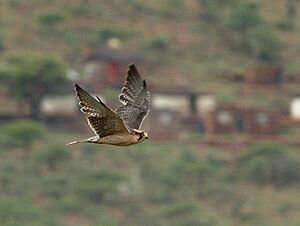
Lanner falcons are large birds. They are about 43 to 50 centimeters (17 to 20 inches) long. Their wings can spread out to 95 to 105 centimeters (37 to 41 inches) wide.
Falcons in Europe have slate grey or brown-grey feathers on their backs. Most African lanner falcons have lighter blue-grey feathers on top. Their chests often have streaks, especially in birds from northern areas. They look a bit like saker falcons, but lanner falcons have a reddish color on the back of their heads.
Male and female lanner falcons look very similar. Young lanner falcons are browner and look even more like saker falcons. However, saker falcons usually have a lighter head and less clear patterns on the sides of their heads. The lanner falcon's call sounds like a harsh "wray-e."
Where Lanner Falcons Live and Their Home
Lanner falcons mostly live in open areas. You can find them from the edges of forests to deserts. They are most common in open grasslands and savannas. In South Africa, they often live in the eastern grasslands. During the non-breeding season, they might move to other areas like Fynbos or the Nama Karoo.
These falcons don't really migrate long distances. They usually make only local movements. These movements might happen because of seasonal rains or changes in altitude. They might live in higher places during breeding season and lower places when they are not breeding.
People sometimes breed lanner falcons in captivity for falconry. This is a sport where people train falcons to hunt. Sometimes, lanner falcons are even bred with peregrine falcons to create "perilanners." Long ago, in the 1600s, there were reports of lanner falcons living in places like Sherwood Forest in England. These were likely birds that had escaped from noble people who used them for hunting. Even King Edward I of England, who loved falconry, owned at least one lanner falcon.
In the wild, the number of lanner falcons is decreasing in Europe and North Africa. However, they are still quite common in some parts of Africa.
Lanner Falcon Life and Habits
Moulting
Female lanner falcons usually shed their old feathers and grow new ones (this is called moulting) from September to January. This happens after they are done nesting. Male falcons moult later, from November to May, once their chicks can hunt for themselves.
Diet
Lanner falcons mostly hunt and eat other birds. This includes doves, pigeons, and even small chickens from farms. They also sometimes eat small mammals, reptiles, and insects. In Africa and Israel, lanner falcons have been seen hunting bats.
Hunting
Lanner falcons usually hunt by chasing their prey horizontally in the air. This is different from the peregrine falcon, which dives from high up. Lanner falcons catch most of their bird prey while flying. However, they use many different hunting styles. They might dive after soaring high, attack from a perch, or attack from a fast, low flight.
Sometimes, lanner falcons even hunt together. They work as a team, especially when hunting birds like jackdaws. They use eye contact to plan their chase. Often, the male falcon starts the attack, but the female usually catches the prey.
Behaviour
Before the breeding season, male and female lanner falcons fly together. Their flights are often closely matched and synchronized from April to June. Near their nesting spots, pairs have also been seen diving together very fast.
Once the eggs hatch, the female mostly stays with and feeds the young falcons. However, the male takes over this job when the female needs to go hunt for food. When the young falcons are about 25 days old, the female is often seen perched near the nest. But she still spends a lot of time inside the nest with her chicks. When the young are about 39 days old, the female doesn't spend much time in the nest anymore. At this point, both the male and female are actively hunting.
Nesting Habits
Lanner falcons usually build their nests on steep cliff faces. They typically lay three or four eggs. They are not very picky about where they nest. Because of this, they are more common and don't have their nests scattered in just a few places. They might also use old crow nests or sometimes even nest on power poles, trees, or less steep cliffs.
Reproduction
Lanner falcons usually lay their eggs in July. This timing helps their young falcons grow up before the hot summer and heavy rains arrive. It also happens before many other birds migrate in December to February. This timing might give the young falcons better chances to find food, which helps them survive.
The success of their breeding is greatly affected by the environment. The eggs are thought to hatch after about 32 days. The young falcons stay in the nest for about 44 days. However, young falcons have been seen near their nests for up to ten weeks after they first learn to fly. On average, about 2.24 young falcons successfully fly from each nest. This is typical for large falcons.
Threats to Lanner Falcons
The lanner falcon is listed as a species of "Least Concern" on the IUCN Red List. This means they are not currently in danger of disappearing. However, human activities can still harm them, both directly and indirectly.
Direct threats from humans include:
- Nest robbery: People sometimes steal chicks from nests for falconry.
- Vehicle collisions: Falcons can get hit by cars.
- Electrocution: They can be harmed by power lines.
- Persecution: Farmers sometimes kill them because lanner falcons occasionally hunt domestic chickens. Young chicks can barely fly when they leave the nest, making them easy to catch.
Indirect threats from humans include:
- Habitat loss: As humans expand, they take away the open spaces where lanner falcons live.
- Pesticides: The widespread use of chemicals for farming can harm the falcons or the animals they eat.
Images for kids
-
A lanner falcon at Kgalagadi Transfrontier Park, South Africa.
-
An adult Falco biarmicus biarmicus in Etosha National Park, Namibia.
-
A young lanner falcon, likely F. b. feldeggi. Notice its blue skin around the face and how it looks similar to a saker falcon.



